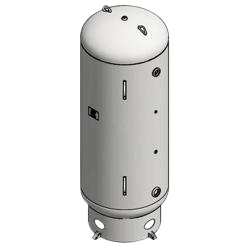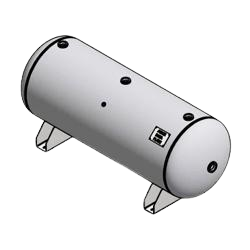
Air receiver tanks typically come in two types — horizontal and vertical. Although they function similarly, space considerations vary. Vertical tanks often work better where space is limited because of their smaller footprints. Sizes of replacement air tanks can range from small 5-gallon tanks to industrial-sized receivers up to 10,000 gallons.
The smaller the air replacement tank, the better the portability. High-capacity tanks typically have feet to provide stability and often require mounting to reduce vibration during operation.

ASME pressure vessel
Base ring mounted
Multiple selectable customization options
Capacity (Gallons) | Dimensions | Max Working Pressure (PSIG) | Arrangement |
30 | 16"x16"x38" | 200 | Vertical |
30 | 16"x16"x38" | 300 | Vertical |
60 | 20"x20"x48" | 200 | Vertical |
60 | 20"x20"x48" | 300 | Vertical |
80 | 20"x20"x63" | 200 | Vertical |
80 | 20"x20"x63" | 300 | Vertical |
120 | 24"x24"x67" | 200 | Vertical |
120 | 24"x24"x67" | 300 | Vertical |
200 | 30"x30"x72" | 200 | Vertical |
200 | 30"x30"x72" | 300 | Vertical |
240 | 30"x30"x84" | 200 | Vertical |
240 | 30"x30"x84" | 300 | Vertical |
400 | 36"x36"x93" | 165 | Vertical |
400 | 36"x36"x93" | 200 | Vertical |
400 | 36"x36"x93" | 300 | Vertical |
500 | 36"x36"x117" | 165 | Vertical |
500 | 36"x36"x117" | 200 | Vertical |
500 | 36"x36"x117" | 300 | Vertical |
660 | 42"x42"x120" | 150 | Vertical |
660 | 42"x42"x120" | 200 | Vertical |
660 | 42"x42"x120" | 300 | Vertical |
1060 | 48"x48"x144" | 155 | Vertical |
1060 | 48"x48"x144" | 200 | Vertical |
1060 | 48"x48"x144" | 300 | Vertical |
1550 | 54"x54"x166" | 150 | Vertical |
1550 | 54"x54"x166" | 200 | Vertical |
2000 | 60"x60"x174" | 150 | Vertical |
2560 | 60"x60"x220" | 150 | Vertical |
3000 | 66"x66"x214" | 150 | Vertical |
3800 | 72"x72"x228" | 150 | Vertical |
5000 | 72"x72"x305" | 150 | Vertical |

ASME pressure vessel
Base ring mounted
Multiple selectable customization options
Capacity (Gallons) | Dimensions | Max Working Pressure (PSIG) | Arrangement |
12 | 12"x12"x27" | 200 | Horizontal |
12 | 12"x12"x27" | 300 | Horizontal |
20 | 14"x14"x33" | 200 | Horizontal |
20 | 14"x14"x33" | 300 | Horizontal |
30 | 16"x16"x38" | 200 | Horizontal |
30 | 16"x16"x38" | 300 | Horizontal |
60 | 20"x20"x48" | 200 | Horizontal |
60 | 20"x20"x48" | 300 | Horizontal |
80 | 20"x20"x63" | 200 | Horizontal |
80 | 20"x20"x63" | 300 | Horizontal |
120 | 24"x24"x67" | 200 | Horizontal |
200 | 30"x30"x72" | 200 | Horizontal |
240 | 30"x30"x84" | 200 | Horizontal |
400 | 36"x36"x93" | 165 | Horizontal |
400 | 36"x36"x93" | 200 | Horizontal |
500 | 36"x36"x117" | 165 | Horizontal |
500 | 36"x36"x117" | 200 | Horizontal |
660 | 42"x42"x120" | 150 | Horizontal |
660 | 42"x42"x120" | 200 | Horizontal |
1060 | 48"x48"x184" | 155 | Horizontal |
1060 | 48"x48"x184" | 200 | Horizontal |
1550 | 54"x54"x166" | 165 | Horizontal |
2000 | 60"x60"x174" | 150 | Horizontal |
2560 | 60"x60"x220" | 150 | Horizontal |
Required storage capacities for compressed air depend on the application. Some factors to consider when choosing the capacity of your replacement tank include:
Among our featured air compressor tanks are the standard air receivers manufactured by Quincy Compressor, Samuel Pressure Vessel, Steel Fab, Sylvan and Manchester Tank. Some of the most popular models include horizontal air receivers, vertical air receivers, horizontal gas-driven tanks and horizontal grasshopper tanks. These tanks offer many excellent features:
Our partners can custom manufacture tanks based on the specific needs of your application. Our engineers can work with you to help determine a set of specifications that best fits your operation.
An air receiver or replacement tank is essential for any compressed air system. The tank’s primary purpose is to provide a reservoir of power during peak demands. The extra storage capacity ensures your compressor’s safe and efficient operation without a system overload.
Another critical function of a receiver tank is removing moisture from the compressed air supply. When warm air emerges from the pump, it contains potentially harmful water vapor. The receiver tank cools and condenses the steam, allowing for easy removal of the moisture through a drain at the bottom of the unit.
At Compressed Air Technologies, we’re an authorized distributor for several of the most reputable compressed air tank manufacturers, including Manchester Tank. Our extensive inventory consists of various models and sizes in multiple configurations. Our expert staff is available to help you determine which air tanks are best suited to fit the needs of your operation.
Using an air receiver tank with your compressed air system can significantly improve your operation’s performance. Some of the advantages include: